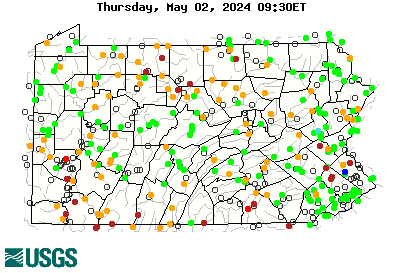You are using an out of date browser. It may not display this or other websites correctly.
You should upgrade or use an alternative browser.
You should upgrade or use an alternative browser.
That Snowpack!
- Thread starter jifigz
- Start date
A man that knows his historyNow, now... "Decimated" means the population was only reduced by one tenth. Those bigfoots will be just fine. 😉
sandflyx
Well-known member
only helps ground water if the ground is thawed. here in tioaga county its all run off in the spring. only a few places where it would help. frost stops penatration of waterThere is no swowpack in PA obv, BUT i do think it helps groundwater recharge that snow melts normally slowly and allows most or all the water to get absorbed into the water table vs running off. After the summer and fall we had rain wise i will take any precipitation any time heading into the spring
bringthepain
Well-known member
only helps ground water if the ground is thawed. here in tioaga county its all run off in the spring. only a few places where it would help. frost stops penatration of water
The ground thaws slightly as the snow melts slowly each day was my assumption. Take your lawn example, it starts hitting 40 and the snow dissappears slowly day by day. There is no visible runoff, i assumed that moisture slowly soaks in. I'm sure it refreezes in the ground each night once absorbed but its there
nymphingmaniac
Well-known member
the thaw of snow in the valleys and ridges around the Spring Creek and LJ has produced a very little bump that's going back down. We didn't have much snow up to this point and its mostly gone. I am hoping what melted made its way to the water table, but it wasn't a lot.
In my very amateur opinion, all moisture helps, Joe!the thaw of snow in the valleys and ridges around the Spring Creek and LJ has produced a very little bump that's going back down. We didn't have much snow up to this point and its mostly gone. I am hoping what melted made its way to the water table, but it wasn't a lot.
Roofin' Trouter
Active member
Modeling guidance suggests above average precipitation for February. We will see...the thaw of snow in the valleys and ridges around the Spring Creek and LJ has produced a very little bump that's going back down. We didn't have much snow up to this point and its mostly gone. I am hoping what melted made its way to the water table, but it wasn't a lot.
salmo
Well-known member
If you think about it snow pack actually insulates the ground. An early snow will keep the ground temperature between 30-32 degrees. The temperature of the snow never gets below 32. However if it is densely packed it reduces the insulating factor.
I'm not sure I believe that sentence.The temperature of the snow never gets below 32.
dudemanspecial
Well-known member
I had a double take there myself, but I think he is saying that the ground temperature will determine the temperature of the snow pack that is insulating it, which is mostly true.I'm not sure I believe that sentence.
Yeah. I know snow is a great insulator, but if it's 0°F out, maybe some of the snow is 32°, but that snow closer to the air and away from the ground is certainly colder than 32°. Right?I had a double take there myself, but I think he is saying that the ground temperature will determine the temperature of the snow pack that is insulating it, which is mostly true.
Right.Yeah. I know snow is a great insulator, but if it's 0°F out, maybe some of the snow is 32°, but that snow closer to the air and away from the ground is certainly colder than 32°. Right?
wildtrout2
Well-known member
Yes! Water freezes and becomes ice at 32F, but ice can certainly be colder than 32F. Why wouldn't snow?Yeah. I know snow is a great insulator, but if it's 0°F out, maybe some of the snow is 32°, but that snow closer to the air and away from the ground is certainly colder than 32°. Right?
Sylvaneous
Active member
- Joined
- Sep 11, 2006
- Messages
- 997
Funny. The little cross roads I live by outside of Franklin is called Mapledale. That orange strip is called Mapledale Till. There are strips and small seams of sand underground.Kinda of geeky, but I had look. Here is a map of the different ice sheets that advanced into PA. Looks like they only ever came so low as the NW and NE corners of the state. I think there were about four continental glaciers that came into Pennsylvania, forget the details.
View attachment 1641239645
So just south of you is Moraine State Park. The geologic terms of moraine and till go together. Loosely speaking a moraine marks the end of glacier and the till is composition of the material from an outflow of glacier.Funny. The little cross roads I live by outside of Franklin is called Mapledale. That orange strip is called Mapledale Till. There are strips and small seams of sand underground.
I was a geography major in college. I had a lot of good earth science classes like geology, climate and weather. Those studies have stuck with me and enjoy getting to explore those topics again.
salmonoid
Well-known member
- Joined
- Jun 19, 2007
- Messages
- 2,741
We obviously don't have permafrost in PA, but as sandfly notes, the ground remains frozen, even when the surface is warm. When it is cold and dry and snow is on the ground, something like 15% of that snow disappears due to sublimation. If the ground is still frozen at depth, another good chunk simply runs off as the snow melts. So probably 75% of that snow runs off on the surface in the form of liquid or goes into the atmosphere as a gas.The ground thaws slightly as the snow melts slowly each day was my assumption. Take your lawn example, it starts hitting 40 and the snow dissappears slowly day by day. There is no visible runoff, i assumed that moisture slowly soaks in. I'm sure it refreezes in the ground each night once absorbed but its there
Reminds me of a homework problem I had to do for a grad class on heat transfer... With a significantly sensitive probe, one could detect and measure the annual surface temperature variations of the earth to some depth, before the internal heat of the earth wiped out the signature of the surface temperature. The problem was to detect how far this temperature signal went in the earth's crust. This would look like some form of a sinusoidal function, with the heat of the summer forming the maximum of the variation and the cold of the winter forming the minimum of the variation; the further from the surface you got, the more dampened the signal became. Of course, the temperature doesn't propagate instantly, so even though the surface might warm up, dig down a foot or two and you still have frost, which is the same reason that if the snow on the surface melts, it may not be going anywhere in the ground at all, because it's still cold down there and water isn't in liquid form!
Fly-Swatter
Well-known member
- Joined
- Mar 23, 2014
- Messages
- 1,281
"Snowpack" aside, the short to mid-term weather outlook seems favorable for a wetter, cooler first half of spring. Check out the forecast from EPAWA (bottom third of this page).
Summary:
February - Above average precip, slightly below average temps (moderately high confidence interval)
March - Slightly above average precip, near to slightly below average temps (moderate confidence interval)
Summary:
February - Above average precip, slightly below average temps (moderately high confidence interval)
March - Slightly above average precip, near to slightly below average temps (moderate confidence interval)





